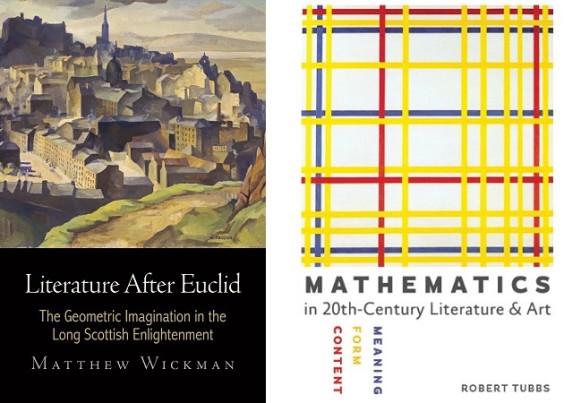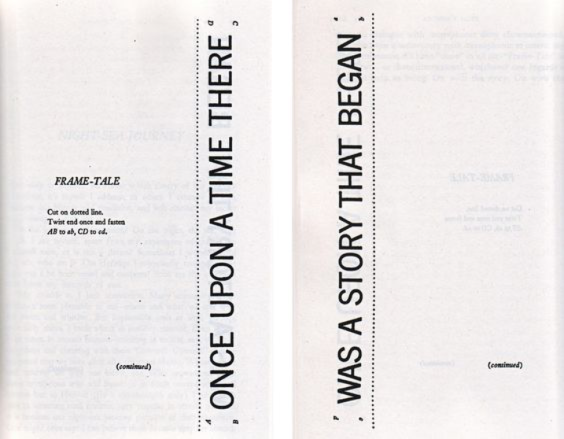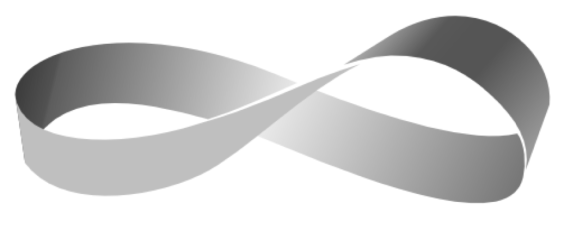
by Deborah Harris

Published by University of Pennsylvania Press (2016), Johns Hopkins University Press (2014), | 304, 184 pages
“ONCE UPON A TIME,” reads the first page of John Barth’s “Frame-Tale.” The second page continues: “WAS A STORY THAT BEGAN.” The story comes with directions and requires scissors.

“Cut on the dotted line,” the directions read, “Twist end once and fasten AB to ab, CD to cd.” With this assembly completed, readers hold a twisted loop.

The story now reads “…ONCE UPON A TIME THERE WAS A STORY THAT BEGAN ONCE UPON A TIME THERE…” Once constructed, the story has no clear beginning and no clear ending. It also has only one side: put your finger on the story, trace your way along the text, and you will find that you have moved from one side of the paper to the other, without lifting your finger. Stories, “Frame-Tale” proposes, turn us inside-out. They warp our minds. And they are endless. These properties are true not only of Barth’s short story, but of a geometric shape first described by nineteenth-century mathematician August Ferdinand Möbius. Stories like Barth’s challenge the widespread belief that anyone who isn’t “good” at mathematics might as well ignore the subject altogether. Ideas like Möbius’s aren’t so much tests or hurdles, as they are invitations to discovery and surprise. In other words, we might learn about the Möbius strip for many of the same reasons we read a novel, look at a painting, or go see a play.
Recent research has shown the inseparability of mathematics from visual art, agriculture, and politics in non-western cultures (see, for example, Marcia Ascher’s fascinating Mathematics Elsewhere). Moreover, mathematics has been foundational to western culture; in the eighteenth and nineteenth centuries, it was nearly impossible to be considered an educated man without substantive fluency in mathematics. When Thomas Jefferson commences the second paragraph of The Declaration of Independence with “we hold these truths to be self-evident,” the points that follow carry the rhetorical force of mathematical proof, with mathematical terms like “equal” and “self-evident.” Victorian novelist George Eliot saw mathematics as so important to intellectual life that she sought out lessons as an adult (women were not routinely taught advanced mathematics), and practiced mathematical exercises daily while traveling in Switzerland.
So it is particularly curious that today, despite widespread calls for interdisciplinary research from within the academy, the arts and the mathematical sciences remain sternly demarcated in contemporary western scholarship, so much so that mathematical and humanistic ideas and methods are often invoked as oppositions. As a result, questions about the relationship between mathematical and artistic thinking remain largely undiscussed. For this reason, recent studies by Robert Tubbs, a mathematician, and Matthew Wickman, a literary critic, are particularly welcome. Both writers make clear why such questions might lead to important critical and pedagogical discoveries—and demonstrate how seeking out interdisciplinary perspectives might make us all better artists, critics, and mathematicians.
In Mathematics in Twentieth-Century Literature and Art, Robert Tubbs asks how mathematics can inspire art and literature. The twentieth century is particularly fitting for such a question. At its beginning, both the arts and mathematics underwent revolutions described as “modernist.” Literary modernism, typified by writers like James Joyce, Virginia Woolf, T.S. Eliot, and Ezra Pound, was deeply experimental. “Make it NEW,” Pound proclaimed to his colleagues, a charge exemplifying literary practice in the period: writers reinvented point of view, plot, omniscience, rhythm, and syntax. In the visual arts, similar creative disruptions flourished, with artists like Piet Mondrian and Marcel Duchamp revealing and challenging central tenets of visual art and its traditions. Mathematicians, meanwhile, labored to understand the foundations of their field. They attempted to prove, for example, that their foundational assumptions were consistent, with results that shook the foundations of mathematics, including Russell’s Paradox (1901) and Gödel's Incompleteness Theorem (1931), which showed that no logical system (even a mathematical one) could be both consistent and complete. To put all this another way, the early twentieth century saw mathematicians and artists returning to the most elementary aspects of their fields, and finding these basics rich, strange, and creatively generative.
Tubbs shows how the mathematical ideas, symbols, and structures circulating in the early decades of the twentieth century unleashed what he calls the “creative energies” of artists and writers, who “appealed directly to diverse mathematical ideas to create and explain both pieces and theories.” Tubbs’s case studies are stunning. Salvador Dali’s painting the The Sacrament of the Last Supper, for example, represents the last supper as if it were taking place inside a dodecahedron, a three-dimensional object made up of 12 regular pentagons. As Tubbs explains, the dodecahedron is one of only five such objects, constructed from repetitions of the same regular polygon. (The most familiar example is a cube, made up of six squares; another is a tetrahedron, made up of four equilateral triangles.) Plato linked these solids to the four fundamental elements: earth, air, fire, water. For Plato, the dodecahedron, the fourth of these solids, represented the heavens. By depicting the last supper within a dodecahedron, Dali combines an immediately striking visual experience with a gradual realization for his viewers of the nature of the shape enfolding the scene. At the same time, Dali summons the mystical history of this particular shape—in Tubbs’s words, “associating Christ with the cosmos.” Just like Barth’s story, Dali’s painting is enabled by geometry. Significantly, Dali draws as much on the dodecahedron’s history as on its geometric properties. Mathematics, Tubbs reminds us, has a culture and a history all its own.
Throughout, Tubbs’s exposition proves so clear and thorough that the mathematical novice reading Mathematics in Twentieth-Century Literature and Art receives an introductory course in the fundamentals of higher mathematics. In prose unburdened by unexplained equations or symbols, Tubbs introduces and explains basic tenets of non-Euclidean geometry, multi-dimensional space, set theory, group theory, graph theory, and number theory. Which is to say: any reader willing to sit with Tubbs for a few hours comes away with basic models for mathematical thinking, as well as a working history of how the visual and literary arts have drawn on mathematical ideas in the twentieth century. Reluctant mathematicians will be delighted to discover that Tubbs’s mathematical explanations afford new analyses of canonical artworks. In fantastic detail, Tubb analyzes visual art ranging from Man Ray’s painting of a hovering globe, entitled As You Like it, to Kazimir Malevich’s equations between geometric shapes and precepts of painting. Literary examples, meanwhile, include Julio Cortázar’s Hopscotch, Gabriel Josipovici’s Möbius the Stripper: Stories and Short Plays, Alain Robbe-Grillet’s In the Labrynth—all texts whose mathematical references and dependencies Tubbs unpacks faithfully and clearly. Tubbs’s book trains readers to regard mathematical and creative thinking as deeply related. Rife with colorful examples that exemplify or draw on mathematical ideas which might otherwise seem abstract or inaccessible, Mathematics in Twentieth-Century Literature and Art is a tremendous teaching tool.
Mathematics can inspire art. Tubbs leaves us with the certainty of this proposition, but also with a host of questions that feel newly pressing. What about twentieth-century mathematics made it inspiring for artists? Might underlying cultural currents have driven the stylistic modernisms that both art and mathematics underwent in the early twentieth century? Were mathematical ideas in the period more broadly compelling than in previous periods? If so, why? If mathematics can inspire art, can art inspire mathematics? Literary critic Matthew Wickman’s Literature After Euclid approaches these questions by considering the cross-pollination of mathematics and literature during the “long Scottish Enlightenment”—roughly, Scotland after its 1707 union with England through the early nineteenth century. As Wickman notes, this period in Scotland reshaped the western intellectual landscape, generating David Hume’s radically skeptical philosophy, Adam Smith’s ground-breaking theories of economics, new directions in historiography theorized by Hume, Dugald Stewart, and their contemporaries, and Walter Scott’s wildly popular historical novels.
Euclidean geometry and Newtonian calculus, constitutive forms of thought in the period, were inseparable from these intellectual endeavors. Mathematical lecturers at Scottish universities included thinkers like Adam Ferguson and Dugald Stewart—both remembered primarily for their historical writing—as well as mathematicians like Colin Maclaurin (best known now for the Maclaurin series, which bears his name). Education involved mathematics as a matter of course, with Euclid playing as central a role to elite education as Latin, the entry point for mathematical pedagogy in the Anglophone world. Comparable in circulation in the period to the Bible, Euclid’s Elements (written circa 300 BCE) consists of 13 books of geometric propositions and proofs, ranging from elementary constructions (such as how to draw an equilateral triangle using only straight edge and compass) to geometric algebra (proving the existence square roots, for example). To put it simply, Euclidean geometry describes space as we perceive it. In Euclid’s world, parallel lines never intersect, wholes are always greater than their constituent parts, and it is always possible to draw a line from one point to another. These are some of Euclid’s introductory axioms, statements so self-evident that they warrant no proof. From these axioms, Euclid builds up a spatial universe, one that went largely unchallenged until the late nineteenth century, when other ways of configuring and understanding space were formalized.
Identifying Euclidean geometry as integral to patterns of thought in the Scottish Enlightenment, Wickman asks how, “in a nation where geometry functioned as a lingua franca” its shapes and figures moved into literary texts. Wickman shows from the get-go how ideas in philosophy and literature preceded mathematical creativity, citing, among other examples, an instance of Hume’s geometric skepticism that prophesies non-Euclidean geometry. Hume points out that the “truths” of Euclid are in fact experiential, and therefore not so much axiomatic truths as empirically derived heuristics. Wickman locates Hume’s observation among several striking anticipations of non-Euclidean geometry, a field of mathematical research that contemplated other systems of geometric thinking in which (to give one example) parallel lines might intersect. As Wickman shows, this kind of counterfactual thinking was in fact a rich literary discourse, as well as a new mathematical frontier. In another tantalizing example of how mathematical ideas structure literary texts, Wickman aligns historical fiction with the geometries of Newtonian fluxions (calculus). Arguing powerfully, if inconclusively, for the logic of this alignment, Wickman shows how both historical fiction and fluxions draw deeply on cultural conceptions of temporality. In explaining fluxions, Newton describes the motion of a point through time (Leibniz, by contrast, largely conceived of differentials of space, rather time). Wickman’s argument, grounded in a reading of a geometric description of the Scottish coast in Walter Scott’s novel Guy Mannering (1815)—“line of sea-coast, with all its varied curves”—will doubtless prove both productive and controversial.
Wickman’s overarching contention is that geometry was “a common language connecting disparate fields,” revealing “something at play in the workings of literary form.” In other words, shape is a mathematically charged category that also happens to be fundamental to the arts—for abstract descriptions of literary form (as in, for example, a “line” of poetry), as well as for descriptions of landscape, verbal and visual. This observation sets the stakes for new frontiers that literary study is only beginning to explore, with a handful of scholars trying to understand the relationship between mathematical and literary thinking in the period. It is largely to its credit, then, that Literature After Euclid frames more questions of literary history than it answers. And the questions are fascinating. How did a culture obsessed with geometrical space configure literary spaces, and how were those configurations carried across time and media? How did geometrical forms influence the calculus as it developed? How did aesthetic theories—that stressed, following the eighteenth-century painter William Hogarth, the line as the locus of aesthetic form—draw on temporalities and geometries intrinsic to Newtonian fluxion?
Literature After Euclid grounds us in a new context, reminding us that a culture immersed in Euclidean geometry could not help but read—and write—differently than we do. As Wickman rightly notes, this organic synthesis offers a rich field for contemporary literary critics, who are just now beginning to think about shape and literature through big data projects, visualization graphics, and distant reading practices. Wickman reminds us just how old that synthesis is, and how strange it would look to an eighteenth-century reader, who would not have regarded our disciplinary boundaries as we do. Interdisciplinary thinking is ancient; only the imperative toward it is new.
Both ambitious books frame the gaps in what we know, revealing the limitations embedded in categorizing knowledge and creativity. Tubbs’s orderly book makes clear that the visual and literary arts depend formally on ambiguities which would bedevil mathematicians: the relation between the dodecahedron and the last supper remains ambiguous, and—Tubbs rightly notes—all the more powerful. Yet Tubbs does not choose to articulate how this fundamental difference functions. One longs for him to invite a Shakespearean to discuss why Man Ray’s painting of a globe might represent As You Like It, rather than Julius Caesar. Or an art historian, to muse upon how difference in medium (the mathematical shapes that Man Ray paints are three-dimensional, the paintings two) matters? One longs, in short, for speculation—which, since Tubbs is a conscientious mathematician, is in short supply. Conversely, Wickman’s insistence that geometry was important culturally leaves this reader with a hunch, rather than a conviction, that the history of mathematical pedagogy and practices in Scotland had massive implications for the Scottish Enlightenment and we who inherit its intellectual legacy. Wickman simply isn’t precise enough about period mathematical history, occasionally proving over-eager to identify every reference to a line, point, or bend as fundamentally mathematical. These lingering quibbles are evidence that Tubbs and Wickman have struck up important conversations that invite continued dialogue across diverse disciplines. Both authors are to be credited for beginning difficult conversations, and for the extent to which they invite other voices into their scholarly books, which are welcome contributions to a culture which all too often tends to segment its thinking into folders, which we hesitate to examine together for fear of growing muddled. The muddle, Tubbs and Wickman show us, is worth the trouble. Mathematics and the arts provide us with the grounding metaphors by which we structure our lives: number, shape, picture, and story. So the question of how these disparate cultural forms collide is of fundamental importance to those who value intellectual history. When we see a plot twist literalized by a folded paper, or an iconic moment from the New Testament refracted through an ancient, mystical shape, we find ourselves somewhere new. Tubbs’s and Wickman’s books, like the complex cultural entanglements they describe, beckon us to new scholarly destinations, inviting us on a journey that’s just beginning.
These lingering quibbles are evidence that Tubbs and Wickman have struck up important conversations that invite continued dialogue across diverse disciplines. Both authors are to be credited for beginning difficult conversations, and for the extent to which they invite other voices into their scholarly books, which are welcome contributions to a culture which all too often tends to segment its thinking into folders, which we hesitate to examine together for fear of growing muddled. The muddle, Tubbs and Wickman show us, is worth the trouble. Mathematics and the arts provide us with the grounding metaphors by which we structure our lives: number, shape, picture, and story. So the question of how these disparate cultural forms collide is of fundamental importance to those who value intellectual history. When we see a plot twist literalized by a folded paper, or an iconic moment from the New Testament refracted through an ancient, mystical shape, we find ourselves somewhere new. Tubbs’s and Wickman’s books, like the complex cultural entanglements they describe, beckon us to new scholarly destinations, inviting us on a journey that’s just beginning.
Margaret Kolb is a Visiting Scholar in the English department at the University of California, Berkeley, where she is working a book relating the near-simultaneous rises of the novel and probability mathematics.















click to see who
MAKE Magazine Publisher MAKE Literary Productions Managing Editor Chamandeep Bains Assistant Managing Editor and Web Editor Kenneth Guay Fiction Editor Kamilah Foreman Nonfiction Editor Jessica Anne Poetry Editor Joel Craig Intercambio Poetry Editor Daniel Borzutzky Intercambio Prose Editor Brenda Lozano Latin American Art Portfolio Editor Alejandro Almanza Pereda Reviews Editor Mark Molloy Portfolio Art Editor Sarah Kramer Creative Director Joshua Hauth, Hauthwares Webmaster Johnathan Crawford Proofreader/Copy Editor Sarah Kramer Associate Fiction Editors LC Fiore, Jim Kourlas, Kerstin Schaars Contributing Editors Kyle Beachy, Steffi Drewes, Katie Geha, Kathleen Rooney Social Media Coordinator Jennifer De Poorter
MAKE Literary Productions, NFP Co-directors, Sarah Dodson and Joel Craig